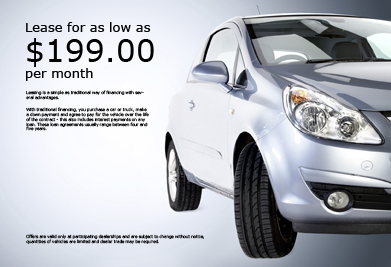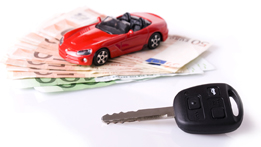Lesson 2
| Site: | MoodleHUB.ca 🍁 |
| Course: | Math 30-3 SS |
| Book: | Lesson 2 |
| Printed by: | Guest user |
| Date: | Sunday, 2 November 2025, 10:03 AM |
Description
Created by IMSreader
1. Lesson 2
Module 2: Number
Lesson 2: Buying or Leasing a Vehicle
Focus

Image Source/Thinkstock
One of the first big purchases young adults make is a vehicle. What type of vehicle suits you best? Do you need a truck so you can haul things? Do you typically have a number of passengers, which would make a van best? Do you have special needs for a small business? These are just some of the questions you have to ask yourself when contemplating getting a vehicle. One of the other big questions will be “How do I pay for the vehicle?”
In this lesson you will investigate a variety of purchasing options available to you when it is time for you to buy a vehicle.
Lesson Outcomes
At the end of this lesson you will be able to
- describe and explain the various options for buying or leasing a vehicle
- solve problems involving the purchase or lease of a vehicle and justify decisions related to this
Lesson Question
You will investigate the following question:
- How can you determine the best purchase or lease option for acquiring a vehicle?
Assessment
Your assessment may be based on a combination of the following tasks:
- completion of the Lesson 2 Assignment (Download the Lesson 2 Assignment and save it in your course folder now.)
- course folder submissions from Try This and Share activities
- additions to Glossary Terms
- work under Project Connection
1.1. Launch
Module 2: Number
Launch
Do you have the background knowledge and skills you need to complete this lesson successfully? Launch will help you find out.
Before beginning this lesson you should be able to describe what interest means with respect to a loan.
1.2. Are You Ready?
Module 2: Number
Are You Ready?
Complete these questions. If you experience difficulty and need help, visit Refresher or contact your teacher.
- Describe what it means to pay interest on a loan. Answer
- What factors will affect the amount of interest paid on a loan? Answer
If you answered the Are You Ready? questions without difficulty, move to Discover.
If you found the Are You Ready? questions difficult, complete Refresher.
1.3. Refresher
Module 2: Number
Refresher
Watch Marty’s Notebook to see an example of a simple interest calculation.
Read the Explore section of Mathematics 20-3 to learn about both simple interest and compound interest.
Go back to the Are You Ready? section and try the questions again. If you are still having difficulty, contact your teacher.
1.4. Discover
Module 2: Number

car: Ingram Publishing/Thinkstock
Discover
You have probably seen commercials on TV or on websites advertising new vehicles. They often quote a lease price per month and have a lot of “fine print” at the bottom.
What is a vehicle lease, and why all the fine print? You will explore these and other questions in the following Try This.
Try This 1
Use your favourite search engine to learn about leasing, and then answer the following questions.
- How is leasing different from purchasing?

- Did you see any options for acquiring an item other than leasing or buying?
- Can you lease anything other than cars? Think of other items to research. Determine whether each item can be bought, leased, or both. The first row is filled in for you.
Item
Buy
Lease
Vehicle


![]() Save your responses in your course folder.
Save your responses in your course folder.
Share 1
With a parent or another adult, discuss the answers to the questions asked in Try This 1.
- Consider the table you created in Try This 1. Are there some items that can only be bought? Leased? Describe why you think this is.
- Given the option, why might someone choose to lease? Why might someone choose to buy?
The following search terms may be useful to you:
- vehicle lease
- lease technology
1.5. Explore
Module 2: Number
Explore
You may have discussed in Share 1 that many types of merchandise can be leased. Cars, computers, and photocopiers are just a few examples. There is a fundamental difference between leasing and purchasing—when you lease something, you don’t own it—you’re just paying the decrease in value due to depreciation. On the contrary, when you purchase something, you own it. There are some vehicle leases that give you the option to purchase the vehicle at the end of the lease term. These types of leases can be called “lease to buy.” The amount to purchase the vehicle is based on the value of the vehicle when the lease is over.
Try This 2

iStockphoto/Thinkstock
Kalila would like to drive a brand new $38 000 sports car. The car dealer has provided her with two options. Both options involve a down payment of $1000, an annual interest rate of 0.99%, and a 48-month term.
Option 1: The first option is to purchase the vehicle. Since Kalila has a $1000 down payment, she ends up borrowing $37 000 at an annual interest rate of 0.99%.
Option 2: The second option is to lease the vehicle. The dealer has indicated the car will be worth $15 000 at the end of the lease. Since this is a lease, Kalila only has to pay the amount the car depreciates, $38 000 − $15 000 = $23 000. With the $1000 down payment, this means she needs to borrow a total of $22 000.
Search the Internet for a loan calculator (use the keywords “loan calculator” as your search term). Use the calculator to determine the monthly payment for the purchase and lease options described above.
![]() Save your responses in your course folder.
Save your responses in your course folder.
Share 2
With a partner or in a group, come to an agreement on answers to each of the following questions:
-
- Which option (purchasing or leasing) has a lower monthly payment?
- Will the option with the lower monthly payment be cheaper overall?
- Why is the difference in the monthly payments for the two options so large?
![]() If required, place a summary of your discussion in your course folder.
If required, place a summary of your discussion in your course folder.
1.6. Explore 2
Module 2: Number
What you should have discovered in Try This 2 and Share 2 is that lease payments can be significantly lower than payments on a loan. The reason for this is that lease payments are calculated using the amount the vehicle has depreciated, as opposed to the purchase amount.
In Try This 2, the depreciation amount was $23 000, which is significantly lower than the amount borrowed for the purchase amount of $37 000. Since significantly less money was borrowed, the payments required to pay it off are much lower.
But there is a catch—because you’re only financing the depreciation amount, you don’t own the vehicle at the end of the lease.
To summarize, there are two main differences between purchasing and leasing:
- When purchasing, you finance the full amount. With leasing, you finance the depreciation amount.
- When purchasing, you own the vehicle at the end of the loan period. With leasing, you do not own the vehicle at the end of the lease.
Now that you have a better understanding of the difference between leasing and purchasing, read “Explore the Math” on pages 298 and 299 of your textbook.
Consider the following more detailed purchasing example:

Thomas Northcut/Lifesize/Thinkstock
Sadia plans to start a small business next summer guiding kayakers on the Kananaskis River. She plans to buy a used truck to pull a kayak trailer. The seller is asking $5400, and Sadia has $1500 she can use for a down payment. She gets a four-year loan for the balance, with monthly payments of $87.89.
What was the total interest charged on the loan?
This problem requires a two-step solution process:
- Step 1: Determine the amount of the loan.
- Step 2: Determine the total amount paid by Sadia when paying off the loan.
Step 1: Determine the amount of the loan.
Sadia has $1500 for a down payment. Therefore, she must borrow the remaining amount from a bank.
$5400.00 − $1500.00 = $3900.00
Step 2: Determine the total amount paid for the loan.
Sadia makes 48 payments of $87.89. Therefore, the total amount she paid for the loan is 48 × $87.89 = $4218.72.
If Sadia borrowed $3900.00 and paid back $4218.72, the difference must be the interest she was charged.
![]()
Often leasing a vehicle will include fees beyond payments and taxes. These can include taxes, a delivery fee, extra-kilometre fees, and a security deposit, which will be returned if there is no excessive damage to the vehicle.
1.7. Explore 3
Module 2: Number
Read “Example 2” on pages 300 and 301 to see another example of calculations for the total interest paid on a loan to purchase a vehicle.
Consider the following leasing example.

iStockphoto/Thinkstock
Example
Juan plans to lease a small vehicle for his catering business. His lease will be for 48 mo, with monthly payments of $208. The residual value will be $6800. The lease conditions specify a 24 000 km allowance per year, with a charge of $0.09 for every additional kilometre.
- If Juan drives a total of 107 000 km, determine the total amount Juan will have paid at the end of the lease.
- If Juan decides to purchase the vehicle at the end of the lease, how much will he have paid in total?
Solution
- The amount Juan pays will have two components: the lease payments and the charge for excess kilometres, since the lease agreement only allows for 96 000 km (4 × 24 000 km).
Lease payments: 48 × $208 = $9984
Extra kilometres driven: 107 000 − 96 000 = 11 000
Cost of extra kilometres: 11 000 × $0.09 = $990
Juan pays a total of $9984 + $990 = $10 974. - The residual value is the amount Juan must pay in order to purchase the vehicle. Therefore, the total amount paid is $10 974 + $6800 = $17 744.
Read “Example 3” on pages 301 and 302 to see another more detailed example of calculations involving the cost of leasing a vehicle. Notice that this example includes extra fees that are part of the lease. Please note, in the solution to part b), the security deposit should not be subtracted, since it had not been added. As a result, the correct solution is: $18 669.12 + $526.57 + $12 195 = $31 390.69 (not $30 890.69, as given in the textbook).
Self-Check 1
Complete “Build Your Skills” questions 1, 3, 4, 6, and 8 from pages 304 and 305 of your textbook. Answer

iStockphoto/Thinkstock
Share 3
- Complete “The Great Debate—Own or Lease” on pages 302 and 303 of your textbook.
- Which method do you prefer? Why?
![]() Save your responses in your course folder.
Save your responses in your course folder.
1.8. Explore 4
Module 2: Number
In Share 3 you likely found advantages and disadvantages of leasing and buying a vehicle. The following table lists some advantages of leasing and buying. Depending on your circumstances, you may find other advantages to both methods of acquiring a vehicle.
Advantages to Leasing |
Advantages to Buying |
|
|
Add the following terms to your copy of Glossary Terms:
- depreciation
- lease
- residual value
1.9. Connect
Module 2: Number
Complete the Lesson 2 Assignment that you saved in your course folder at the beginning of the lesson. Show work to support your answers.
![]() Save your responses in your course folder.
Save your responses in your course folder.
Project Connection
You are now ready to apply your understanding of buying or leasing a vehicle to Module 2 Project: Owning and Operating a Small Business. Go to the Module 2 Project, and complete Part 2: Business Vehicle.
![]() Save your responses in your course folder.
Save your responses in your course folder.
1.10. Lesson 2 Summary
Module 2: Number
Lesson 2 Summary

Hemera/Thinkstock
In this lesson you learned two main differences between leasing and purchasing.
- When purchasing, you finance the full amount. With leasing, you finance the depreciation amount.
- When purchasing, you own the vehicle at the end of the loan period. With leasing, you do not own the vehicle at the end of the lease; however, you may have the opportunity to purchase the vehicle at the end of the lease.
You also explored the issues to be investigated when deciding whether to lease or purchase a vehicle, and the advantages of buying or leasing a vehicle.

